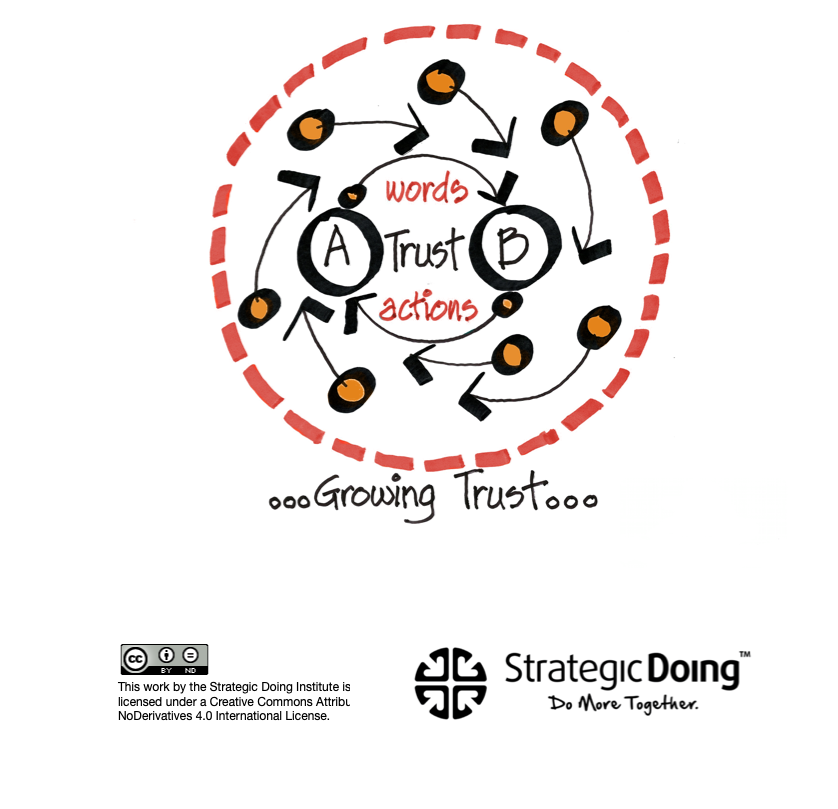Where does trust come from?
This week, a colleague from the National Institutes of Health asked some important questions about trust. How do we build trust in Strategic Doing? How do we measure trust?
First things first. Trust emerges from patterns of behavior in which words align with actions.
In our work, we have learned that we can induce feelings of trust across a network or collaboration by establishing reliable patterns in which words align with actions. This pattern emerges by following a discipline or protocol of simple rules.
In Strategic Doing, we do not measure trust. We measure the outcomes produced by networks. We find that networks that follow a protocol of the simple rules perform more productively than those that don’t (Nilsen et al., 2017).
Trust is not directly observable. It is a feeling, an intuition, an expectation that emerges from interactions within a relationship or a network.
As Francis Fukuyama (1996) has written, trust is an essential component of our civil society. The level of trust in our civil society, he argues, helps explain the vitality of our economic life.
Other scholars have taken this work further. Zak and Knack (2001) demonstrate that low trust societies are often caught in a poverty trap. Acemoglu and Robinson, in their book, Why Nations Fail, argue economies prosper when the civic institutions surrounding and supporting the economy are inclusive, not extractive. Putnam’s early work exploring why northern Italy performs so much more productively than southern Italy also explores this theme (Putnam, 1992).
In sum, trust is intimately tied to an economy’s capability to prosper.
So, too, with organizations.
But how do we get there? Some years ago, practitioners in the field of international development uncovered a concept they called “positive deviance”. The concept emerged from child nutrition and public health in the 1970s. Practitioners identified the idea and then replicated it in several settings in the 1990s to improve child nutrition. In many communities of at-risk populations with malnourished children, a few individuals followed unusual and beneficial practices to achieve better outcomes. (Zeitlin, 1991; Marsh et al., 2004; Pascale et al., 2010)
From this work, they learned that we can behave our ways into new ways of thinking.
In sum, collective habits build trust within an organization or across a network. That’s what Strategic Doing provides: a practical path to building trust through discipline. New, shared habits emerge that generate measurable outcomes.

References
Acemoglu, D., & Robinson, J. A. (2012). Why nations fail: The origins of power, prosperity, and poverty. Currency.
Fukuyama, F. (1996). Trust: human nature and the reconstitution of social order. Simon and Schuster.
Marsh, D. R., Schroeder, D. G., Dearden, K. A., Sternin, J., & Sternin, M. (2004). The power of positive deviance. BMJ, 329(7475), 1177-1179.
Nilsen, E., Morrison, E. F., Ascencio, R., & Hutcheson, S. (2017). Getting ‘‘there’’: Understanding how innovation and entrepreneurship become part of engineering education. American Society for Engineering Education, Paper ID, 18624, 25-28.
Pascale, R. T., Sternin, J., & Sternin, M. (2010). The power of positive deviance: how unlikely innovators solve the world’s toughest problems. Harvard Business School Press.
Putnam, R. D. (1992). Making democracy work: Civic traditions in modern Italy. Princeton University Press.
Zak, P. J., & Knack, S. (2001). Trust and growth. The economic journal, 111(470), 295-321.
Zeitlin, M. (1991). Nutritional resilience in a hostile environment: positive deviance in child nutrition. Nutrition Reviews, 49(9), 259-268.

The Founder of the Lab at UNA and co-author of Strategic Doing: 10 Skills for Agile Leadership, Ed’s work has focused on developing new models of strategy specifically designed to accelerate complex collaboration in networks and open innovation. He is the original developer of Strategic Doing.
